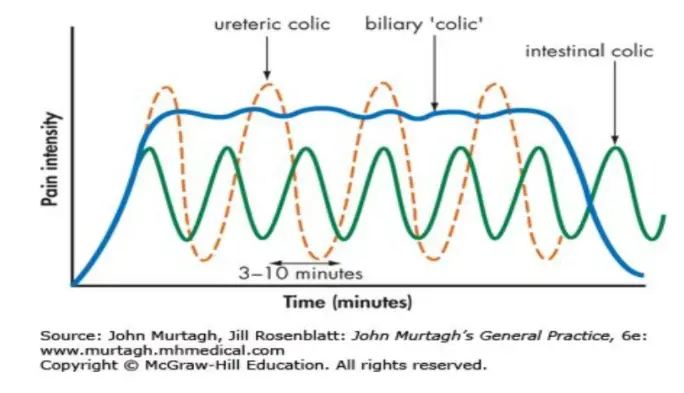Stomach Pain that Comes and Goes in Waves: Causes Explained simply.
Our content is not intended nor recommended as a substitute for medical advice by your doctor. Use for informational purposes only.
What you need to know
- The main 3 sources of colicky abdominal pain (that comes and goes in waves) are colon, biliary, and ureteric pain.
- Irritable bowel syndrome and acute gastroenteritis are the most common causes of waves of abdominal pain that come and go.
- Gall bladder waves of pain last longer and are more intense (usually, they are due to a stone in the gallbladder or the bile duct).
- Ureteric colic is very intense pain in the loin or the lower sides of your abdomen. It is usually caused by a stone in the ureter or kidney.
- Other less common causes of abdominal pain such as ovarian, uterine, and cancer pain are discussed in detail below.

1- Irritable Bowel Syndrome (the most common cause of chronic stomach pain).
Irritable bowel syndrome (IBS) is very common. Approximately, 10-15% of the world population have IBS (reference).
IBS is a functional gut disease. “Functional” means no definite physical lesion or infection can be detected in your gut.
IBS is characterized by chronic abdominal pain that comes and goes in waves. Abdominal pain is associated with a change in bowel habits (diarrhea or constipation).
The exact cause of IBS is still unknown. However, many theories tried to explain the cause of IBS.
Commonly, IBS is associated with emotional stress, ingestion of certain types of foods (such as FODMAPs). Learn more about the causes of IBS HERE.
How to suspect IBS (symptoms).
Interestingly, up to 50% of people with IBS don’t even know they have it (reference). This means that you may have IBS, but the symptoms are not severe enough to seek medical advice.
IBS can cause chronic stomach pain that comes and goes in waves. The waves are called colic, which usually originate from colon spasms.
According to ROME IV criteria for IBS diagnosis, IBS is considered when:
- Abdominal pain: You will feel a “crampy” sensation, that is variable in its intensity. It comes as a wave of colic that lasts for a minute or two disappears, and reappears as a “waves”.
- The pain usually is related to bowel movements. Commonly, it decreases or disappears after defecation.
- In a small subset, the pain may increase after bowel movements.
- Altered bowel habits: periods of either constipation or diarrhea or alternating constipation and diarrhea.
- To diagnose IBS, You should experience stomach pain consistently for a long period. The pain should come at least a day per week for several months.
If you think your symptoms are consistent with IBS, please read this great article. It is about the diagnosis of IBS, from a doctor’s perspective.
The ultimate diagnosis of IBS requires a medical evaluation by your doctor. This is important to exclude similar conditions that mimic IBS.
2- Acute gastroenteritis (the most common cause of ACUTE stomach pain).
Infection or food poisoning can cause acute abdominal colics. The condition is most commonly caused by stomach viruses (stomach flu).
But other types of bugs such as bacteria, protozoa, helminths can cause such conditions.
Acute infections of your gut tract (gastroenteritis) are the most common cause of “acute“ stomach pain that comes and goes in waves.
How to suspect acute gastroenteritis (symptoms).
- The symptoms suddenly start and often last for a few days (2-5 days).
- Abdominal pain: sudden onset of cramps (in the lower or the upper part of your abdomen). The colics are usually more severe (intense waves of cramps that come and go).
- Sudden onset diarrhea (loose or watery stool, more than 3 motions per day).
- Vomiting: is common with viral gastroenteritis.
- Nausea and loss of appetite.
- Fatigue, and muscle aches (malaise).
- Fever is usually low grade in viral and protozoal infection. But it may become a high grade (exceeding 38.5°C) with bacterial gastroenteritis.
3- Gall bladder pain (biliary colics).
Waves of short durations (usually seconds to a minute or two) are often of colonic origin.
When the wave becomes more intense, more prolonged (for about 30 minutes), you should suspect gallbladder pain (biliary colic)
.
Causes of gall bladder pain
- Gallstones.
- Acute cholecystitis (a more severe form with fever, and vomiting).
- Micro-lithiasis (tiny stones or mud) inside the gall bladder.
- Non-calcular gall bladder pain (functional gallbladder pain or non-calcular cholecystitis).
How to suspect biliary colic (symptoms):
- The waves of pain usually start after eating heavy or fatty meals.
- The pain starts gradually and builds up over a period of 30-60 minutes per wave.
- The intensity decreases or goes and comes again with the same pattern.
- The pain is often very intense.
- Nausea (after meals) is very frequent with biliary colics.
- Vomiting also can occur.
- The combination of high intensity, relatively longer waves of pain together with nausea is characteristic of biliary colic.
3- Kidney and ureter pain.
Renal colic or ureteric colic usually indicates a stone inside your urinary tract. Gastrointestinal, biliary, and ureteric pains are the chief 3 causes of abdominal pain that come and go in waves.
Renal colic tend to recur. so the pain is likely renal if you have a history of previous kidney stones or gravels.
How to suspect (symptoms).
- Site of pain, the kindy pain usually at the sides of your abdomen (loin area). the pain can be on one or both sides.
- The ureter pain usually presents at the lower right or left part of your abdomen and can extend to the inner thing and the back (loin).
- Sudden onset of a very intense wave of pain that is not related to movement (moving doesn’t worsen the pain unlike appendicitis).
- Very intense waves of pain can be associated with nausea and vomiting.
- Burning urine, changing the color of urine (bloody or cloudy), or passage of a stone can occur with renal colic.
4- Menstrual cramps, and ovarian pain (females only).
This is a very common cause of abdominal pain that comes and goes in females. The pain is usually related to the time of menstruation.
The most common time of menstrual cramps is just before the menses or during the first two days. conditions such as endometriosis or uterine fibroids can worsen menstrual cramps.
How to suspect (symptoms).
- The pain starts 1-3 days before the menses, reaches its maximum 1 day after the beginning of the menses, and begins to a subsite on the 2nd or the 3rd day of the menses.
- The pain is felt in the lowermost central part of your abdomen.
- Usually, it is dull, continuous pain, but it can also feel like waves of abdominal cramps that comes and goes.
- The pain may radiate to the lower back and thighs.
- You may experience nausea, headache, and dizziness with menstrual cramps.
Menstrual cramps are common. they usually are benign in nature. Ask for medical help if:
- The pain is severe enough to interrupt your daily activities.
- Late-onset of menstrual cramps (after the age of 25).
- The cramps worsen month over month.
5- Food intolerance or allergy.
Food intolerance and food allergy are relatively common conditions. when your digestive system is sensitive to certain types of food, it can cause symptoms similar to irritable bowel syndrome. read the table below to know the main differences between food intolerance and allergy.
Food intolerance | Food allergy |
Affects 15-20% of the population | Affects nearly 2-5% of adults |
Difficulty digesting certain types of food (not immune-mediated allergy). | An immune-mediated reaction to certain foods or food components. |
Causes “recurrent acute” or “chronic” attacks of colicky abdominal pain and diarrhea (which can be yellow diarrhea). | Usually causes acute attacks related to the ingestion of offending food. |
Intestinal symptoms: diarrhea, extensive gas, bloating, and abdominal pain (that comes and goes in waves). | Intestinal symptoms are the same |
No extra-intestinal symptoms | Extraintestinal symptoms like rashes, urticaria, swollen lips or face, or severe life-threatening allergic reactions. |
The severity of your symptoms is proportional to the amount you eat from the offending food. | Even trace amounts of the offending food can produce severe symptoms. |
Common offending foods:
| Common offending foods: (examples)
|
6- Less common causes:
The below causes are either:
- Common conditions but rarely present with abdominal pain that comes and goes in waves.
- Or less frequent conditions that typically present with waves of abdominal colics.
A- Inflammatory bowel disease (Crohn’s and ulcerative colitis).
A relatively less frequent condition. However inflammatory bowel diseases (IBD) typically present with abdominal pain that is colicky (short waves of pain).
In IBD, immune dysregulation causes chronic inflammation and ulcers in the colon (ulcerative colitis). Also, the inflammation and ulcers may involve the entire gut tract (Crohn’s disease).
B- celiac disease.
Celiac disease is a sensitivity to a protein called “gluten”. Gluten is found in wheat, rye, and barely. Eating such foods causes abdominal colics (that comes and goes in waves), diarrhea, malabsorption of nutrients, and anemia.
C- Urinary tract infection.
Urinary tract infection can cause loin pain (similar to that of kidney stones). Usually, the condition is associated with painful urination, a change in the color of urine, and maybe fever.
Learn more about the symptoms of urinary tract infection.
D- Cancers (commonly, stomach, colon, pancreatic, and ovarian cancer).
Abdominal cancers (such as stomach, colon, pancreatic, or ovarian cancer) rarely present with colicky pain. Pain from cancer is usually dull, progressive, and continuous pain.
Rarely, do these types of cancer present with waves of abdominal cramps. usually, other associated symptoms such as blood in stool, and change in bowel habits are present.
E- Gastritis and peptic ulcer disease.
Gastritis and PUD are very common. However, the pain is often in the form of dull, growing, or burning in character. It is located in the upper central part of your abdomen.
Waves of abdominal pain that come and go are NOT suggestive of gastritis or peptic ulcer disease; unless you define (waves) as days with pain and days without pain.
Learn more about gastritis and PUD.
When do you need to see a doctor?
- Abnormally very intense waves of pain (may suggest biliary or renal colic).
- Presence of unexplained fever.
- Unexplained weight loss.
- Intense nausea and/or vomiting.
- Blood in stool.
- Severe tenderness when you or someone touches your abdomen.
MORE:
- Evidence-based
- Written by a doctor.












